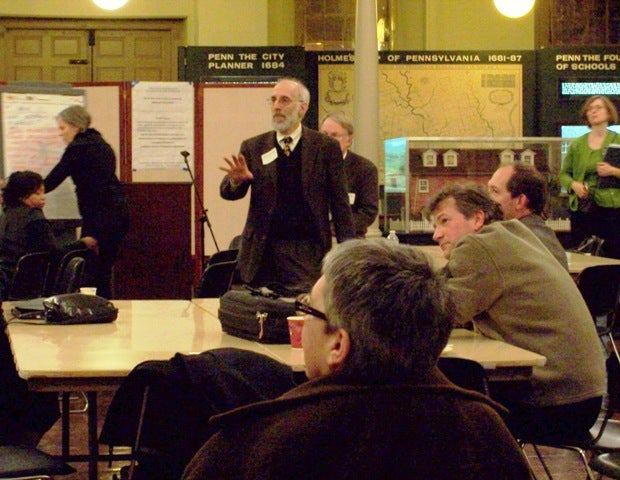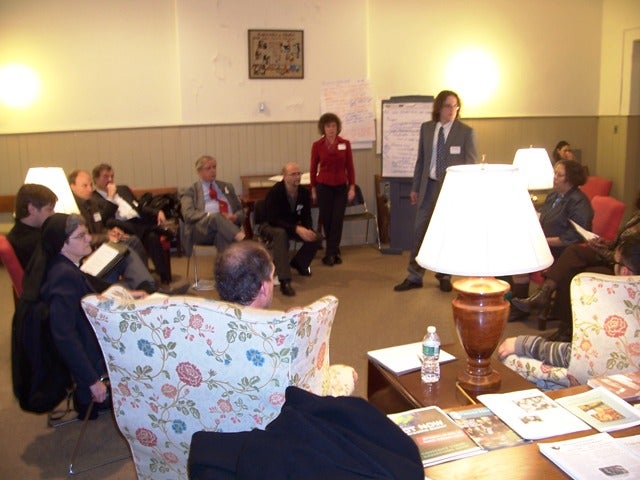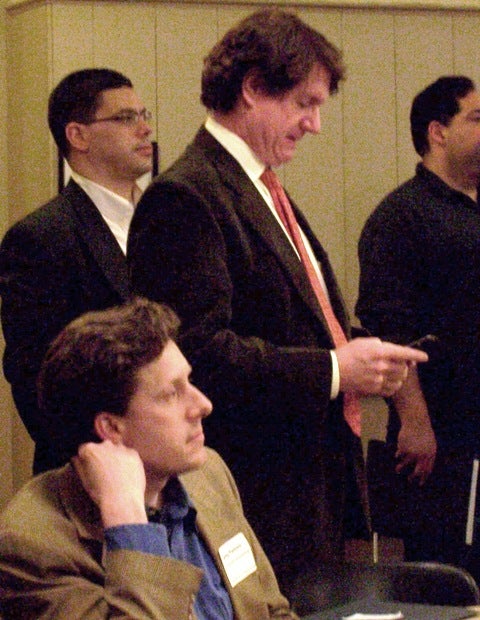Developers face civic groups at final ‘Common Ground’ event
January 28, 2010
By Thomas J. Walsh
For PlanPhilly
In the end, there was the low-hanging fruit, and there were the gut-wrenchers.
After about 10 hours of brainstorming over the course of two days last week, more than 40 representatives from Philadelphia community groups and developers, met at the Arch Street Friends Meeting House in Old City. With more than 20 observers, they were there to hash out common ground – to gather it, document it and send it along for inclusion in the city’s zoning code re-write efforts that should conclude later this year.
It was the third and final meeting of the series arranged by the Penn Project for Civic Engagement (PPCE) at the University of Pennsylvania and the local chapter of the American Institute of Architects, called “Common Ground for Building Our City.”
On Jan. 19, the first meeting – with developers, land use attorneys, economic development officials, architects and other professionals – was held at the Union League. The second meeting – with neighborhood groups, civic associations and community development corporations – was held on Saturday (Jan. 23) on the campus of Temple University’s Medical School in North Philadelphia.
The series of deliberative workshops sought to provide input to the Zoning Code Commission (ZCC) and its efforts to include public participation in the drafting of the new code. As they were for the first two meetings, members and staffers of the Zoning Code Commission and Philadelphia City Planning Commission were invited to attend as observers. And as it was with the first two forums, attendees’ comments during the workshops and breakout sessions, and their presence, were off-the-record.
“Once again tonight we are going to ask you to set aside the ‘either-or,’ ‘winner-loser’ way of thinking,” said Kiki Bolender, a Philadelphia architect and AIA member. Bolender and Penn professor Harris Sokoloff, director of the PPCE, hosted all three meetings. Arrangements were led by Linda Breitstein, project manager for the PPCE.
“We’re not talking about compromise,” Sokoloff said. “We’re talking about common ground.” The workshops were meant to be “deliberative and not argumentative.”
The forums provided an opportunity for the development community and civic leadership to meet and help formulate the basics of how communities will have a voice in development decisions, the PPCE Web site states. “For the first time, neighborhoods and developers will help define how the process should work. … We’re more likely to have a project review process that will be transparent, effective and enriching to the neighborhoods and the city as a whole.”
“This is not going to be some up-in-the-air, 20,000-foot conversation here tonight,” Sokoloff told the assembled, as they dined on chicken, Swedish meatballs, carrot cake and coffee. The four topics included in the category called “low-hanging fruit” came from the previous days’ breakout sessions and were issues that yielded “significant common ground across the development community and civic leadership.”
I’m OK with that.
For instance, there was agreement from both sides that the process for public input should be different for projects considered “major” versus “minor.” The challenge: where to draw that line? Should it be a set amount of square feet to be built, or should there be differing thresholds for different kinds of development? One developer suggested 10, or maybe 20, apartment units for residential construction (below that number is “minor;” above it is “major”). Keep in mind that even small projects often have major impacts, the participants were told.
The issue of timelines and early notification of development plans was also an area both sides came together on. The earlier a neighborhood knows of a project, the better – with information sources ranging from Facebook pages to old-fashioned phone trees. But who is responsible beyond the familiar orange signs? More to the point, is the calendar the best means of constructing a timeline? Why not use “process markers” instead? For the latter, the idea is that a developer might have ‘x’ number of days to meet with the public after a project is drawn up “in concept,” but before going before the Zoning Board of Adjustment or the Planning Commission (or both). Perhaps the initial meeting with the designated community group is the action that sets the clock ticking on a timeline.
A developer in one group pointed out that the larger the project, the bigger the financial risk, so the scale of a given effort is quite relevant to the concept of a timeline. The neighborhood people in his group, gathered in comfortable chairs in the Meeting House’s living room area, agreed with him that whatever the forthcoming guidelines, each side should have “adequate – but not unlimited,” time to state their cases. The developer must be able to make measurable progress, and the neighborhood must at some point coalesce behind a single voice – yea or nay.
Paraphrasing Mick Jagger, one neighborhood activist uttered a truism that only zoning freaks would get right away – that you can’t always not get what you don’t want.
Another low-hanging apple was “transparency:” “Many agreed that it would help if the project review process and decisions of the ZBA were more transparent,” the PPCE wrote in its group work summary. “They agreed it would reduce criticism that those decisions were arbitrary, whimsical, or subject to political influence.”
Speaking with their gut
The “gut wrenchers” were more challenging.
Who speaks for the neighborhood, for starters? “Too often non-representative groups or individuals succeed in pawning themselves off as the ‘voice of the neighborhood’ in discussions about projects,” the PPCE wrote. Or, “different groups and individuals show up to different meetings” for one specific project. Should just one civic group be determined to be the “official” representative group?
Indeed, one developer said that just one person with a beef has the ability to harpoon a project that could turn a struggling neighborhood around. State law is such that one person filing an appeal means it’ll be about a year before a ruling. Most developers – at least, the small or medium-sized players – will walk at that point, he said, and never come back.
In the group PlanPhilly was observing, the question of overlap came up. What if neighborhoods mesh together, as they often do, especially in the more residentially dense areas of the city, such as South Philly and the Northeast?
And what about citywide groups that have an interest in development, for, say, design standards or preservation work? What priority do they get when it comes to giving the ultimate thumbs-up or thumbs-down?
Of-right or if-wrong
The new code will almost certainly increase the percentage, by a great deal, of projects approved “as of right,” since so many current zoning and overlay districts, and antiquated classifications, will be consolidated.
So what are the “triggers” here? Which projects will get reviewed, and how? How should zoning review be sorted from design review, since so many community concerns are about details that are not technically zoning – such as aesthetics and architectural styles?
Should design review be left to the pros, or does it all have to pass muster with the people living nearby? What about traffic and noise? Are they part of design review?
Gut wrenchers, alright. In fact, we’ll just skip right over the issue of “councilmanic privilege” as it relates here.
In the worksheets handed to participants, the PPCE listed the issues, the common ground discovered for each, a “task” and a nudge labeled “do not:”. For the topic of project review – which ones get it, why and how – the underlying, tongue-in-cheek plea was, “Do not: Kill each other over this issue.”
As he did for the first two forums, Sokoloff kicked off the evening by quoting from the Hebrew “Pirkei Avot” (or, “Ethics of the Fathers”): “You are not required to complete the work, but neither are you free to desist from starting it.”
More information:
The PPCE compiled reports on results and feedback from the first two meetings (see below). “The project will serve an advisory function, developing a set of common ground principles, and perhaps a model, for the project review process,” the PPCE Web site states. “For its part, the ZCC has agreed to respond to the common ground principles by acknowledging the substance of the report and the ways in which it will and will not address that substance.
“This does not mean that the ZCC has agreed to apply all of the principles that emerge from these deliberative workshops. The ZCC has, however, agreed that it will explain which principles it adopts and how and why, and which it decides not to adopt and what it does instead and why.”
Contact the reporter at thomaswalsh1@gmail.com.
Click here for a 29-page PDF report on the Civic Leaders Workshop held Jan. 23, 2010 and for PDFs of each the four Development Community Reports (from one to seven pages) from workshop held Jan. 19, 2010.
WHYY is your source for fact-based, in-depth journalism and information. As a nonprofit organization, we rely on financial support from readers like you. Please give today.







